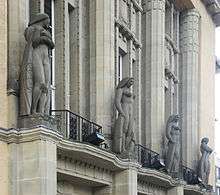Milly Steger
Milly Steger (June 15, 1881 – 1948) was a German sculptor.

Steger born in Rheinberg as Emilie Sibilla Elisabeth Johanna Steger, and was educated at a boarding school in London. While there, she took instruction in painting and decided to become an artist. From 1903 to 1906, she received private training in Düsseldorf, as women were not currently allowed to attend the arts academy. She moved to Berlin in 1908, where she began teaching at the Academy of the Ladies Society of Berlin Artists. Steger was invited by Karl Ernst Osthaus to Hagen in 1910, where she was commissioned to create the first large-scale architectural sculpture for the city, creating four statues of women for the facade of the Hagen Theater. She completed a number of other public commissions until World War I. Returning to Berlin in 1917, Steger spent much of the rest of her life teaching drawing and sculpture. Notable avant-garde patron Katherine Dreier collected her work, but much of Steger’s unsold work was lost when her studio was destroyed during World War II. Just before her death in 1948, Steger was named the honorary president of the Democratic Women’s League of Germany.[1][2]
References
- ↑ Power, Intelligence. "Milly Steger (German, 1881-1948) - Biography". www.artfinding.com. Retrieved 2017-08-11.
- ↑ "Revolt, They Said". www.andreageyer.info. Retrieved 2017-08-10.
![]()